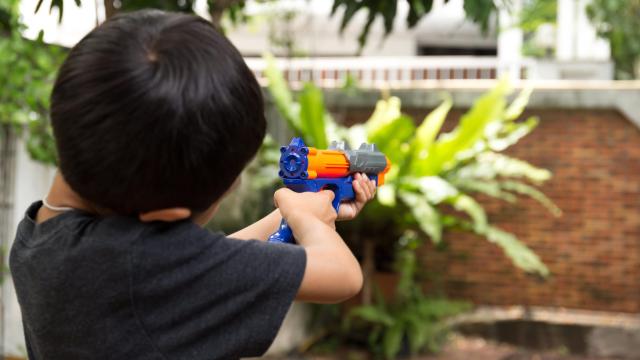My oldest son had never been so excited to make a Target run. He was flush with birthday gift cards, and since he has never had the opportunity to purchase his own toys before, it was the perfect moment to stroll through the aisles in search of something he really wanted. His eyes got especially wide when he saw the wide assortment of foam dart guns down one lane.
I had one as a kid, but owning a toy like that nowadays could be considered problematic, at best, and maybe even harmful. Parents of children of colour certainly have reasons to be concerned about their kids playing with toy guns, and The BMJ published in 2017 that three people (two adults and one child) came to their local emergency room with pain and blurred vision thanks to being on the business end of a dart fired from a NERF gun.
To their credit, Hasbro told the BBC in a statement that, “NERF products are designed based on years of consumer insights and research, and undergo rigorous reviews and testing to assure that they are safe and fun to play with, and meet or exceed global standards and regulations. NERF foam darts and foam rounds are not hazardous when used properly.”
Still, I steered my son past the toy gun aisle, and after a bit more exploring, my dino-obsessed kid settled on an egg that contained a mystery mini-carnivore, along with some other Jurassic-related items, similar to what one might find on YouTube “unboxing” channels like Ryan’s World. Of course, these videos — and the toys that come with them — have problems of their own, as Michael Rich, director of Boston Children’s Hospital’s Centre on Media and Child Health and associate professor of pediatrics at Harvard Medical School, explained to Fatherly:
“Kids watching these videos learn that what makes people happy is getting stuff. I call it consumer porn because the delight and joy is in the unveiling, the unwrapping, and the unboxing, saying, ‘Oh, look what I have!’ But it’s a very ephemeral, fleeting moment because you’re then onto the next thing and the next thing and the next. It’s about the surprise and discovery. And it’s a discovery not of something that stimulates their imagination or creativity, but channels it into this preordained story.”
To Rich’s point, it was fun removing everything from the slime-filled packages, but five minutes later, my son had already lost interest. It seemed like he spent his own money for the experience of opening a box instead of the contents inside, and he immediately wanted to go back to Target to get another one. (And I should’ve paid more attention to the label and its multiple warnings about small parts and glowing slime.)
In addition, there is a seemingly endless barrage of stories of toys that enforce gender stereotypes or cause a scary and expensive trip to the emergency room. They’ve been around for years (candy cigarettes, anyone?), but it’s difficult for a concerned parent to know the damage, both physical and psychological, that a purchase might cause. The issue seems to be even more complicated by things like social media and unboxing videos, which can intensify a kid’s desire for these toys that maybe aren’t as great as they seem.
Tell us: Are there toys you won’t buy your kids because of the harm they could cause? What products do you consider too harmful or “problematic” to purchase for your kids (or allow them to purchase for themselves)? What are your rules for playing with those toys at someone else’s house? In the comments, share what’s on your “Do Not Buy” list and how you reached your decision.

Leave a Reply
You must be logged in to post a comment.